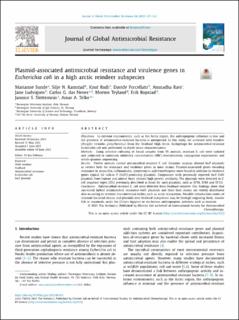| dc.contributor.author | Sunde, Marianne | |
| dc.contributor.author | Ramstad, Silje N. | |
| dc.contributor.author | Rudi, Knut | |
| dc.contributor.author | Porcellato, Davide | |
| dc.contributor.author | Ravi, Anuradha | |
| dc.contributor.author | Ludvigsen, Jane | |
| dc.contributor.author | das Neves, Carlos Gonçalo | |
| dc.contributor.author | Tryland, Morten | |
| dc.contributor.author | Ropstad, Erik | |
| dc.contributor.author | Slettemeås, Jannice S. | |
| dc.contributor.author | Telke, Amar A. | |
| dc.date.accessioned | 2021-11-16T12:58:00Z | |
| dc.date.available | 2021-11-16T12:58:00Z | |
| dc.date.created | 2021-10-22T10:52:10Z | |
| dc.date.issued | 2021 | |
| dc.identifier.citation | Journal of Global Antimicrobial Resistance. 2021, 26 317-322. | en_US |
| dc.identifier.issn | 2213-7165 | |
| dc.identifier.uri | https://hdl.handle.net/11250/2829859 | |
| dc.description.abstract | Objectives
In extreme environments, such as the Arctic region, the anthropogenic influence is low and the presence of antimicrobial-resistant bacteria is unexpected. In this study, we screened wild reindeer (Rangifer tarandus platyrhynchus) from the Svalbard High Arctic Archipelago for antimicrobial-resistant Escherichia coli and performed in-depth strain characterisation.
Methods
Using selective culturing of faecal samples from 55 animals, resistant E. coli were isolated and subjected to minimum inhibitory concentration (MIC) determination, conjugation experiments and whole-genome sequencing.
Results
Twelve animals carried antimicrobial-resistant E. coli. Genomic analysis showed IncF plasmids as vectors both for resistance and virulence genes in most strains. Plasmid-associated genes encoding resistance to ampicillin, sulfonamides, streptomycin and trimethoprim were found in addition to virulence genes typical for colicin V (ColV)-producing plasmids. Comparison with previously reported IncF ColV plasmids from human and animal hosts showed high genetic similarity. The plasmids were detected in E. coli sequence types (STs) previously described as hosts for such plasmids, such as ST58, ST88 and ST131.
Conclusion
Antimicrobial-resistant E. coli were detected from Svalbard reindeer. Our findings show that successful hybrid antimicrobial resistance–ColV plasmids and their host strains are widely distributed also occurring in extreme environmental niches such as arctic ecosystems. Possible introduction routes of resistant bacterial strains and plasmids into Svalbard ecosystems may be through migrating birds, marine fish or mammals, arctic fox (Vulpes lagopus) or via human anthropogenic activities such as tourism. | en_US |
| dc.language.iso | eng | en_US |
| dc.publisher | Elsevier | en_US |
| dc.rights | Navngivelse 4.0 Internasjonal | * |
| dc.rights.uri | http://creativecommons.org/licenses/by/4.0/deed.no | * |
| dc.title | Plasmid-associated antimicrobial resistance and virulence genes in Escherichia coli in a high arctic reindeer subspecies | en_US |
| dc.type | Peer reviewed | en_US |
| dc.type | Journal article | en_US |
| dc.description.version | publishedVersion | en_US |
| dc.source.pagenumber | 317-322 | en_US |
| dc.source.volume | 26 | en_US |
| dc.source.journal | Journal of Global Antimicrobial Resistance | en_US |
| dc.identifier.doi | 10.1016/j.jgar.2021.06.003 | |
| dc.identifier.cristin | 1947806 | |
| cristin.ispublished | true | |
| cristin.fulltext | original | |
| cristin.qualitycode | 1 | |

